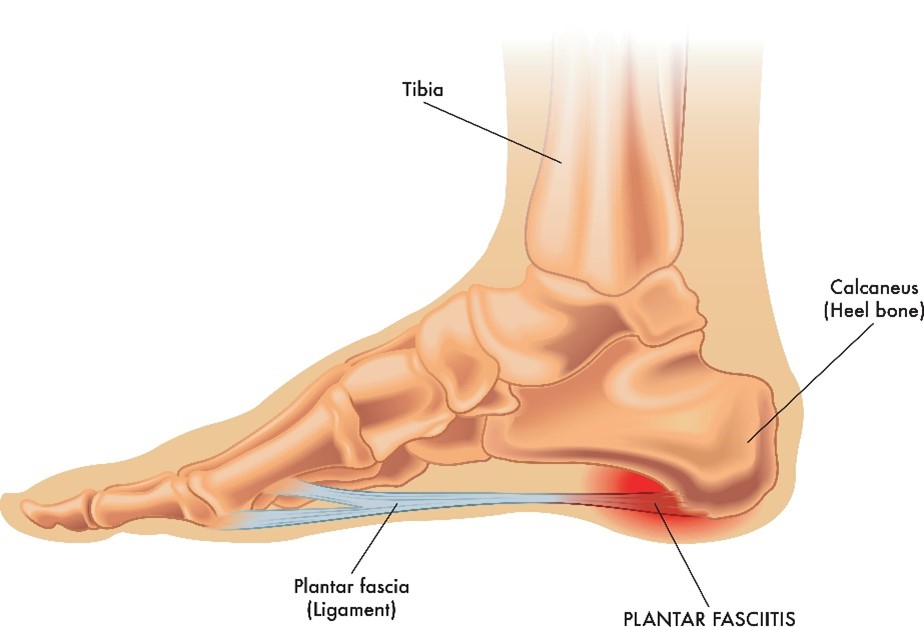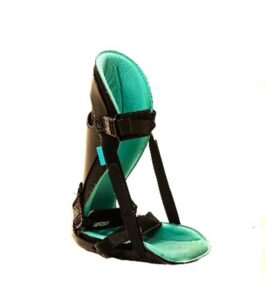Why Can’t I find Relief from Plantar Fasciitis?
Are you asking yourself this question but don’t know where to turn? We’re here to help. Plantar fasciitis is a common condition affecting people of various ages. To understand what plantar fasciitis is and why it occurs, a brief overview of the anatomy of this region of the foot can be very useful. To begin, we will breakdown the anatomy of the plantar fascia and how it relates to daily activities.
Is Plantar Fasciitis a Tendon or Ligament?
The Plantar Fascia is a connective tissue structure that originates from the heel bone and inserts at the flexor tendons at the base of the toes. The plantar fascia consists of three bands, the medial band, central band, and lateral band. These help to support the arch of the foot and assist with normal foot mechanics while walking. While individual anatomy may vary, most people have a broad ledge of bone at the base of the heel where the plantar fascia begins. This is commonly referred to as a “heel spur” but is a normally occurring structure that does not contribute to development of Plantar Fasciitis symptoms.

Why Won’t My Pain Go Away?
Plantar fasciitis refers to symptoms of pain on the bottom of the heel. Often people experience heel pain with the first steps out of bed in the morning, when standing for long periods of time, or with transitioning from sitting to standing positions. These symptoms often occur from wearing non-supportive shoes or from an increase in weightbearing activities. Symptoms may also arise spontaneously. Treatment is often required to help symptoms resolve.
Who Treats Plantar Fasciitis?
Plantar fasciitis is often diagnosed clinically by an orthopedic provider who specializes in Foot and Ankle conditions. The provider will evaluate your symptoms and likely order radiographs, otherwise known as X-rays, to help diagnose and treat plantar fasciitis. If needed, an MRI may be ordered to rule out any other potential causes of pain.
How to Treat Plantar Fasciitis

A multitude of treatment options may be utilized to resolve or lessen plantar fasciitis symptoms. Many people respond well to conservative therapy. Therefore, this is often the first course of action for the treatment of plantar fasciitis. A major component in conservative treatment is supportive footwear. Walking barefoot on hard floors or walking in non-supportive shoes may exacerbate symptoms. Due to this, sneakers with thick, cushioned soles are commonly recommended for plantar fasciitis as they provide extra support to the heel with weightbearing. Some recommended shoe options include the brands HOKA and Oofos.

In addition to supportive shoes, other devices may also be incorporated for additional relief. A gel heel cup can be added to shoes for extra cushion.
Furthermore, some doctors may recommend a brace to find relief. Bracing involves the use of a night splint while you sleep, which helps to keep the foot in a neutral dorsiflexed (toes toward your head) position and assists with reducing morning symptoms
Physical Therapy for Plantar Fasciitis Pain
Physical therapy is another vital component of conservative treatment for Plantar Fasciitis. Tightness in the Plantar fascia is often found in association with tightness in the calf muscles and the Achilles tendon. A program specific to stretching the plantar fascia and the Achilles tendon may provide marked relief for your plantar fasciitis symptoms. Other modalities in physical therapy such as ultrasound or dry needling can also be utilized. Often a 4–6-week program is initially recommended, although additional physical therapy may be required. Recovery time with conservative management varies based on severity of symptoms, lifestyle, and compliance to the treatment regimen. Click here to learn 3 stretches you can do at home to help with Plantar Fasciitis pain.
How to Relieve Plantar Fasciitis Pain at Home
In addition to your prescribed Physical Therapy exercises, oral NSAIDs (non-steroidal anti-inflammatories such as ibuprofen, Aleve, Advil, etc.), rest, and ice can aid in providing symptom relief while at home. The use of supportive house shoes and avoidance of walking barefoot can also help alleviate symptoms and prevent pain.
Additional Treatments Options
If conservative treatments fail, an injection may be the next best step. Steroid injections are a common treatment option; however, they are associated with increased risk of plantar fascia rupture and fat pad atrophy. Due to these risks, steroid injections should be avoided if possible. A safer alternative to steroid injections is a treatment called PRP or Platelet Rich Plasma. PRP for Plantar Fasciitis involves collecting plasma from your own blood and then injecting this nutrient rich substance into the plantar fascia to help promote healing. While not yet FDA approved, this has been shown as a very effective treatment option for many patients struggling with Plantar Fasciitis symptoms. There is a brief period of down time following PRP injections. This typically involves patients being placed into a cast for a couple of weeks followed by a walking boot. Physical therapy is utilized in conjunction to optimize improvement. After 6-8 weeks most patients will begin gradual return to full activity.
Mechanism of Injury for Plantar Fasciitis
The plantar fascia can also be susceptible to rupture or tear with sudden insult or injury to the tissue. Often, plantar fascia rupture or tear occurs in patients with a history of steroid injections. This is a further indication to caution the use of steroid injections as a treatment modality. Symptoms of a Plantar Fascia rupture includes a sudden popping sensation in the arch of the foot followed by tenderness and bruising. If you happen to experience such symptoms, please seek out attention from an orthopedic specialist. An MRI may be ordered to confirm the tear and then a conservative treatment program will be prescribed for you. Treatment of a Plantar Fascia rupture typically involves a period of immobilization and management of symptoms with ice and NSAIDs. Recovery can take a couple of months and some patients may still have chronic symptoms as a result of the injury.



